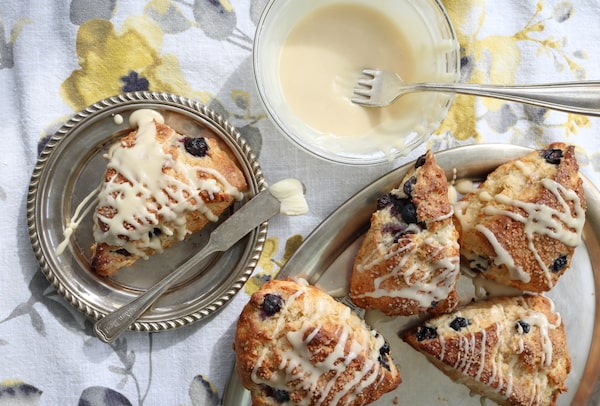
Birch (or Maple) Syrup Scones can be made using either type of syrup.Julie Van Rosendaal/The Globe and Mail
Across Eastern Canada, it’s sugaring season – the sap of sugar maples (as well as a few other maple species) has been flowing since February, while the birch trees up north have only just begun their harvest period, which generally starts in mid-March.
First Nations and Métis communities have harvested birch and maple sap for centuries, and taught European settlers to tap trees in the spring and boil their sweet liquid down into syrup and sugar. Birch syrup is slightly thicker and more complex, flavour wise, than maple; it’s not as sweet, with a slightly mineral, citrusy, almost savoury flavour.
Birch syrup isn’t limited to Northern climates. In Alberta, chef Tracy Little of Sauvage in Canmore taps trees at the nearby Stewart Creek golf course. She simmers the sap herself, and uses the resulting syrup in place of brown sugar in desserts and savoury sauces.
“It goes incredibly well with coffee, chocolate or even spicy barbecue flavours,” she says. “Our current application is for a glaze we put on our grilled hen of the woods mushrooms, and in the vegan chocolate dessert with sea buckthorn berries.”
Unless you live in a community that produces it, birch is pricier and more precious, though maple is also becoming increasingly so. (It takes about 100-150 litres of sap to produce a litre of birch syrup, compared with about 40 litres of sap for a litre of maple syrup.) Production of both is highly vulnerable to weather conditions, which affect both timing and sugar content of the trees’ sap. Canada’s maple syrup reserve – the only one in the world – has hit a 16-year low owing to demand and the effects of climate change.
In the kitchen, birch and maple syrups can be used interchangeably. Where it’s abundant, birch syrup is poured freely over pancakes and waffles and used in baked goods; if you can only access a tiny bottle, it’s delicious as a finishing drizzle over toast, scones and oatmeal, roasted veggies and sharp cheeses, brushed over fish or used in vinaigrettes.
Birch (or Maple) Syrup Scones
The flavour of maple or birch syrup often becomes muted in baked goods. For a more pronounced flavour in cakes, add a capful of maple extract, or finish cookies and scones with a maple drizzle.
2 1/2 cups all-purpose flour (or half all-purpose, half oat or barley flour)
2 tbsp brown sugar
1 tbsp baking powder
1/2 tsp salt
1/2 cup butter or brick-style plant butter, cut into pieces
3/4 cup milk (any kind)
1/4 cup birch (or pure maple) syrup
1/2 to 1 cup fresh or frozen blueberries (optional)
¼ to ½ cup chopped pecans (optional)
coarse sugar (optional)
Drizzle:
2/3 to 3/4 cup icing sugar
1 tbsp birch (or pure maple) syrup
1 tbsp milk (any kind) or cream
Preheat the oven to 425 F.
In a medium bowl, stir together the flour, brown sugar, baking powder and salt. Add the butter and blend it in with a pastry blender, fork or your fingers until well combined, with bigger lumps the size of a blueberry still remaining.
Stir together the milk and maple syrup (this is easy in a liquid measuring cup), add it to the flour mixture and stir just until the dough comes together, adding the pecans and/or blueberries (don’t thaw them if they’re frozen), if using, as you stir.
Turn the dough out onto a parchment-lined sheet and pat into a circle about an inch thick. Cut into six to eight wedges and pull them apart on the sheet. If you like, brush them with a little extra milk and sprinkle with sugar.
Bake for 15-20 minutes, until deep golden. Meanwhile, whisk together the icing sugar, syrup and milk, and drizzle it over the warm scones with a fork.
Makes six to eight scones.
Editor’s note: A previous version of this recipe omitted the option of including ¼ to ½ cup chopped pecans. This version has been updated.